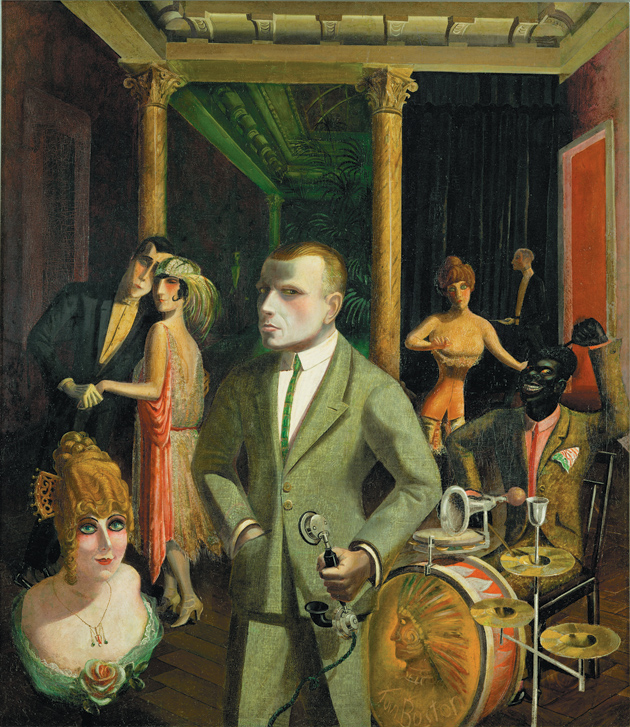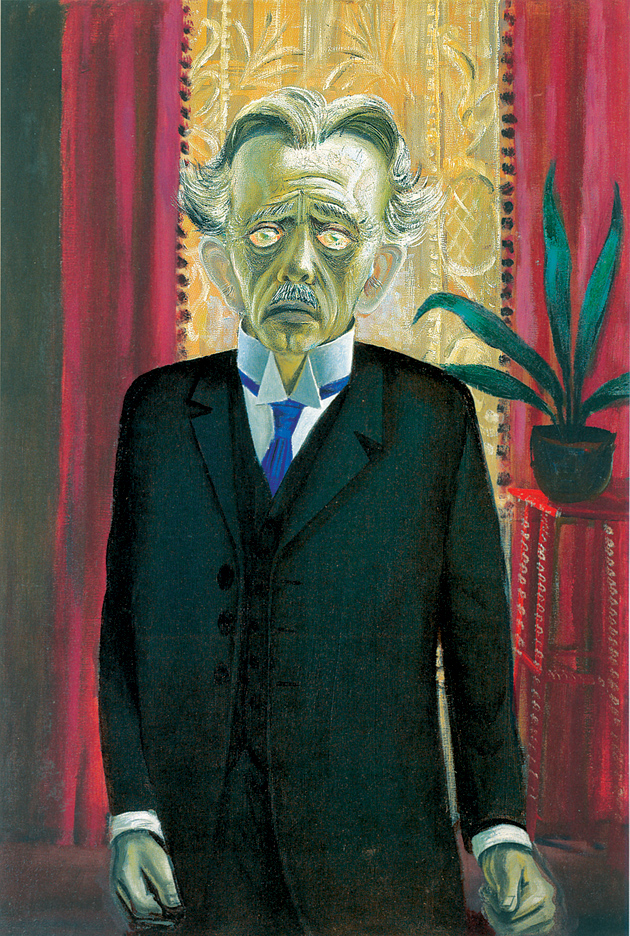
© 2010 Artists Rights Society (ARS), New York/VG Bild-Kunst, Bonn/Von der Heydt-Museum, Wuppertal/Erich Lessing/Art Resource
Otto Dix: To Beauty, 55 x 48 inches, 1922. The figure in the center is a self-portrait of Dix. For a slideshow of works discussed in this review, see the NYR blog, nybooks.test/blog.
In 2006, the Metropolitan Museum opened one of the most engrossing shows of twentieth-century art it has ever done. This was “Glitter and Doom: German Portraits from the 1920s,” a beautifully selected look at the work of Max Beckmann, George Grosz, Otto Dix, and a number of lesser-known figures—including Karl Hubbuch, Ludwig Meidner, and Christian Schad—during the notoriously fraught era bounded, on one end, by the conclusion of World War I and, on the other, by the rise of Hitler. Concentrating as it did primarily on portraits, the exhibition managed both to give a strong taste of the Weimar Republic of legend—the society unhinged by its unimaginable war losses, barely functioning economy, unstable politics, and uninhibited, and often deviant, sexuality—and to go behind it. That is to say, for all that we were given a view of fat, cigar-chomping factory owners, hideously crippled veterans, streetwalkers, and transvestites, we also encountered a wide range of fascinating faces onto whom we could project, or might choose not to project, the tensions of the time.
Organized by Sabine Rewald with a connoisseur’s feeling for works with a bracing formal presence, the show erased much of what might have seemed dated about the era. It wasn’t a surprise—yet it felt good to see it so plainly reconfirmed by the works on view—that Max Beckmann’s pictures, with their way of presenting faces of a mysterious yet not off-putting aloofness, had a solidity that put him in a different category from his compatriots. The paintings of Christian Schad, in turn, with their fastidious realism at the service of a lidded and sexualized mood, where people have the unnerving presence of lizards, were hard to take your eyes from. But the motor behind “Glitter and Doom” was Otto Dix. His fifty-odd paintings and drawings, good-sized in both cases, made up a little over half of the exhibition, and, arresting in their ambition and often cartoonish energy, they were something of a revelation.
The Met’s show was the first time most of us had seen so much of the work of Dix—who was born in 1891 and died in 1969—and the chief impression it left was of an artist who operated with a charging, sometimes outrageous, sense of freedom. It wasn’t exactly because, in his account of the topsy-turvy Weimar years, he outdid George Grosz and everyone else in the gleeful frankness with which he showed an array of aged prostitutes with breasts sagging to their waists, or veterans of the trenches missing legs, chins, eyes, and much of their cheeks, or sadists and their bloodied victims. What was unexpected and remarkable about Dix was, rather, the will-try-anything way in which he put paint on canvas and the fluency with which, in his portraits of professional men, children, and older women, he could move from one stylistic approach to another.
Dix is now the subject of his first large American exhibition, at the Neue Galerie. Coming within memory of “Glitter and Doom,” its timing is perfect. And the good news is that, put together by Olaf Peters, it includes some of the strong painted portraits from the Met’s show, along with a few of equal quality that were not in it. Also here are Dix’s extraordinary suites of prints from the 1920s—particularly Circus and Der Krieg (War)—that were outside the scope of “Glitter and Doom.” The Neue Galerie’s exhibition, focusing on the years 1919 to 1939, gives us a second chance to appreciate an artist who at times could almost be our contemporary.
In such wonderful (or at least eye-opening) works here from the years 1920 to 1922 as the portraits of a painter named Franz Schulze, say, or of a businessman named Max Roesberg, or Lady with Mink and Veil—a decrepit person who toothily smiles nevertheless—Dix puts oil on canvas with a limberness that not many German painters of the time can match. E.L. Kirchner, by comparison, who is all told a more substantial artist than Dix, never seems to be having as much physical and experimental fun in the making of his paintings as Dix does in these early-1920s pictures.
While the endearing portrait of Max Roesberg, with its memorable green, has a folk-art-like stiffness of form and an untaught artist’s exaggerated sense of neatness and clarity, the portrait of Franz Schulze, whom we see before a cracked wall, is impetuous in its brushwork and has a devil-may-care compositional awkwardness. (It recalls Alice Neel in her early years, when she was making her discoveries.) Elsewhere, Dix delineates facial and bodily features like some combination of political cartoonist and illustrator of scary children’s books—as when in the portrait of a lawyer named Fritz Glaser he so emphasizes the man’s hooked nose as to make the picture immediately appear to be an image of a stereotypical Jew. In the portrait of a psychiatrist named Heinrich Stadelmann, the rims of the man’s wild green eyes are not only orange but the eyes themselves bulge out from the canvas. It is as if Dix were working with a child’s literalness and using oil paint as a sculpting material.
Advertisement
Yet in operating as a caricaturist in frequently large works that exude an overall pride of craftsmanship, Dix makes a viewer think again about the idea of taste. He draws details and uses colors in ways that certainly ask to be labeled bad taste—or plain offensive—but his best pictures leave you more with a sense of an ebullient daring than of anything cynical, pathetic, or even mean-spirited. In the Fritz Glaser painting, the telltale nose is merely one of many oddities—including the picture’s strangely derelict setting and the way, in the background, we unaccountably see an ornate building draped in snow—that give the work its spirit of something operatic, artificial, and dreamlike.
Yet the Neue Galerie’s exhibition is also a sobering letdown. It makes clear what was already evident in the works from the later 1920s in the Met’s show: as this decade went along, Dix’s art lost its formal unpredictability and its acidic and satirical tension. He gave up his feeling for folk art and for areas of thick paint, and he slowly relinquished his way of letting himself become seemingly transfixed as he recreated certain decorative details within the picture—something you see in the mesmerizing pants he wears in the 1923 Self-Portrait with Nude Model. In their stead, he took up a thin, highly controlled way of applying paint, with oil and tempera put on smooth, gessoed surfaces, that, for him, purposefully echoed age-old German realist traditions.
With his new approach he continued to show a world of people with pronounced eyes and exaggerated bodily mannerisms; but the pictures have less life as paintings per se. In canvases from the later 1920s on, such as the often reproduced 1925 portrait of a flamboyant dancer named Anita Berber—she of the seriously lipsticked mouth and vixen’s slinky red dress, surrounded by a background of the same hot red—Dix’s feeling for unconventional sitters or representative types feels more stated than worked out in the painting. The weird and uncomfortable note he strikes comes to seem brittle and programmatic.
But while Dix himself is of course responsible for the increasingly illustrational nature of his work, the Neue Galerie has been flat-footed for its part. Where the Met’s show gave us twenty or so elegantly lean and incisive pencil drawings from throughout the Weimar years, the Neue Galerie has essentially skipped them and gone instead for an excessive number of Dix’s watercolors, which become monotonous fairly quickly. And as it is not likely that another American museum will be taking an in-depth look at Dix anytime soon, it is strange that the organizers of the present exhibition didn’t aim for more of a full retrospective. We are given little tangible sense of what the artist went on to do in the last three decades of his life.
Nor does the exhibition impart more than a vague and skimpy idea of what Dix did before the Weimar period (although Dietrich Schubert’s essay in the catalog, which is accompanied by some relevant illustrations, does handle the topic). This is unfortunate, because Dix could be a lively and sometimes impassioned artist before 1919 (especially in self-portraits from his youth onward); and it was his earlier experiences—principally as a soldier during the war—that propelled him into making his high-wire work in the 1920s.
The son of working-class people (his father was employed in an iron foundry), Dix apparently found out who he was when, with an education almost exclusively in schools and studios for fine and decorative art, he first read Nietzsche. The philosopher’s vision of a man of eagle-eyed, pitiless superiority, with no time for sentiment or propriety, and determined to welcome the instinctual in life no matter how base, became Dix’s vision. Luckily, he could really live a Nietzschean existence as he was fearless, even intimidating, in his person. Volunteering for the front in 1915, after a year’s training—he later wrote about World War I that “I couldn’t possibly miss it”—Dix fittingly served as a machine gunner and, eventually, machine gun troop leader (and recipient of an Iron Cross, Second Class); he saw fierce action on the Western and Eastern fronts right to the end. It is safe to say that few other artists of any nationality participated in as much combat as he did—or, perhaps, killed as many men in the line of duty as he did.
Advertisement
He seems to have seen art, and the art world, as merely another field of war in which you do what you can to one-up your competitors. When, during the war, he wasn’t fighting, he was busy recording the explosions and decimation he witnessed in pictures that, in reproduction—and as I remember them from Richard Cork’s tremendous 1994 London exhibition “A Bitter Truth: Avant-Garde Art and the Great War”—were often assured and even brilliant. They show him to have been keeping track of, and expertly digesting, Futurism, Cubism, and whatever else advanced artistic thinking was up to.
Set loose on the German art world after the war, he quickly became notorious for the sheer daring with which, in pictures that were often huge in size (and were in most cases eventually destroyed or lost), he confronted viewers with phantasmagorically intense images of such subjects as death in the trenches or the spectacle of the war’s maimed veterans. He made gruesomely detailed paintings on the theme of sex murders; and, his pictures disturbing people beyond art circles, he was taken into court on two occasions (and acquitted both times) on charges of making obscene paintings.
Much as Max Beckmann was doing it at the same time, Dix made himself, in many self-portraits, his work’s protagonist. In paintings and drawings, he emphasized his hooded eyes and grimly unsmiling line of a mouth, and he wore his hair combed straight back, in the new “American” style. (He became deeply absorbed in the new American dance crazes of the time, too, and even thought, after he married, that he and his wife, Martha, might become professional dancers.) In his single richest and most layered picture, the 1922 To Beauty (which is not in the present show), he stands in the center of a nightclub, garbed in a dazzlingly painted oatmeal-colored suit, grasping a telephone, every part of his body beaming forth guardedness and threat.
With his steely and suspicious visage and blondish straight hair, Dix could pass, in his self-portraits, for a Hollywood Nazi. The actual Nazis, in 1933, determined that his work, with its almost carnivalesque attitude toward loss and degradation, was morally reprehensible. He was forced to give up his professorship at the Dresden Academy of Art, which he had held since 1927 and which, given the difficulty of selling his demanding pictures, enabled him and his wife and their three children to live. He signed on to a Nazi program that at least allowed him to continue working as an artist; but he was “partially banned from exhibiting his art,” we learn, and with his Weimar-era paintings held up to ridicule in state-organized shows, he was essentially sent into a kind of retirement. He moved with his family to the south, to Lake Constance, and contented himself making landscapes. He seems to have lived a quiet life until 1945, when he was drafted into the militia. Perhaps fortunately, he was captured and spent nearly a year in a French prisoner-of-war camp.
By that time Dix’s artistic approach had changed entirely. He now painted with a consistently brushy roughness (occasionally recalling the English realist John Bratby, who became known in the late 1950s), and he tried his hand at all types of subjects. But making portraits of people who challenged him in some way continued to bring out the most in Dix. A 1967 portrait of the Swiss novelist Max Frisch, for instance, seen in color in the pages of Fritz Löffler’s standard work on the artist, appears to be a pretty punchy work.
And it is faces—smug, cruel, demented, paralyzed with horror, or simply paralyzed—that linger with us longest from Dix’s great suites of prints, the 1922 Circus and Der Krieg, published two years later. In these works Dix brings together the most graspable components of his art: his predilection for seeing people as types and marionettes, his ability to jump easily from style to style, and his way of letting the nature of his artistic materials, whether runny, blotch-prone, filigreed, or scratchy, have a determining say. In the etchings that make up Circus, where we see magicians and equestrian acts, trapeze artists, and toylike people who have barely any relation to circuses, the tensions of the early Weimar years seem to be falling under the spell of something fantastic and folkloric. You fall under the spell of the prints themselves when you look at them closely and discover the range of textures and kinds of markings Dix gets, seemingly all off-the-cuff, with his etcher’s needle.
The fifty etchings comprising Der Krieg offer a feast of different surfaces and varying drawing styles as well. But then the images themselves, showing life in the dugouts, trenches, and fields, at sunrise and at night, also amount to a definitive account of the fighting of World War I. A viewer wonders whether anyone could go further in the presentation of the savagery, hopelessness, muck, and derangement of combat. Circus and Der Krieg would put Dix on the map of world art even if he had never painted. Taken together, they also neatly happen to encompass the experience contained in the words “glitter and doom.” Except that, as Dix saw the era, the words might be more like puppetry and catastrophe.
This Issue
August 19, 2010
The Crisis & the Euro




